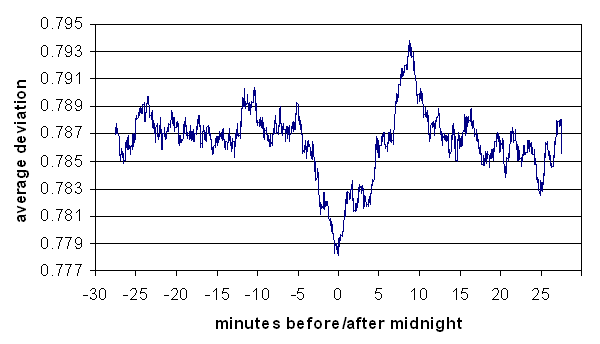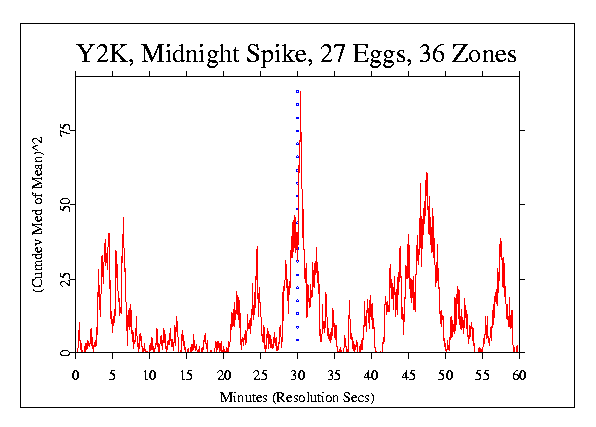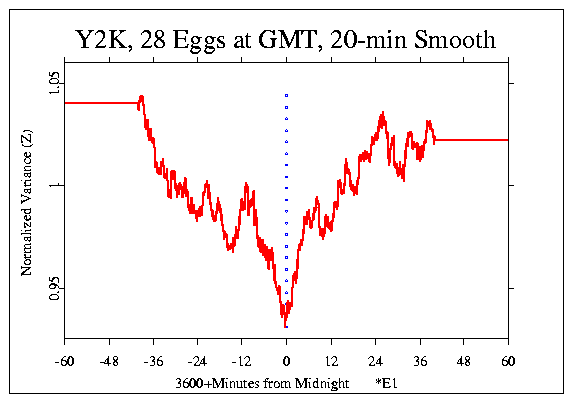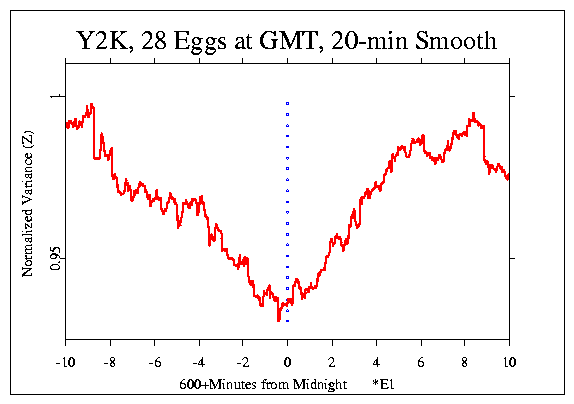The combined deviation drops precipitously as midnight approaches, and
reaches its extreme minimum at three seconds before midnight, the
moment of transition.
Deviation of normalized variance, GCP Data, Y2K

This striking figure indicates a sharply focused effect just at midnight, as
predicted.
The
following graph displays changes in the deviation of the mean trial value
across eggs over the time
surrounding the Y2K transition. The cumulative sum of the median of the squared
deviation of the mean
from its empirical expectation is plotted, revealing a striking spike at
midnight.

Interpreted literally, this
suggests a brief but very sharp increase in the absolute deviations of trial
outcomes just at the moment of
greatest engagement in the New Year's celebration.
A permutation analysis
shows that the maximum deviation is not extremely rare, with a greater value
appearing somewhere in
90.3% of the permuted datasets. The placement of the spike so close to midnight
(it maximizes at 24
seconds after) is, however, quite unlikely; a 4000-permutation analysis yields
a p-value of 0.022 of a
spike occuring this close or closer to midnight. The combined probability of a
spike this large and this close
is p = 0.020, suggesting that we might expect to find such impressive structure
merely by chance only
twice in 100 repetitions of the Y2K experiment.
Notes added in November 2000: I had thought about the first, remarkable
spike figure that
Dean produced, which he said was wrong because it focused on midnight,
GMT only. In an effort to understand this better, I concluded that
there might have been a cumsum involved, which under certain conditions,
can lead to a spike roughly in the middle of a dataset.
I explored simpler ways of looking at the variance, concentrating on the
GMT focus, and found many indicators of a special time near midnight.
The following figures show the normalized variance (the deviation from
expectation expressed as a Z-score) for the two hours surrounding
midnight, and a 20 minute detail. The data are smoothed with a 20
minute running mean window.


Afterword, on interpretation, RDN
These results, and some others in the GCP database, have generated considerable
commentary, and among the "alternative" explanations which are offered is the
suggestion that it may all be an "experimenter effect." This is not meant as a
suggestion that there is anything wrong with the machines, or the protocols,
but as an interpretation that the source of the effect is not some sort
of global consciousness, but the intentions, the consciousness of the
experimenters. I mentioned this concern
to a sage I know and she said, "So what? We can all be experimenters."
That made me laugh, for it does so succinctly put the
point that a real effect in this stuff is meaningful, even
if it doesn't mean what we might have wished,
or what we imagined we could show.
Return to top
GCP Home